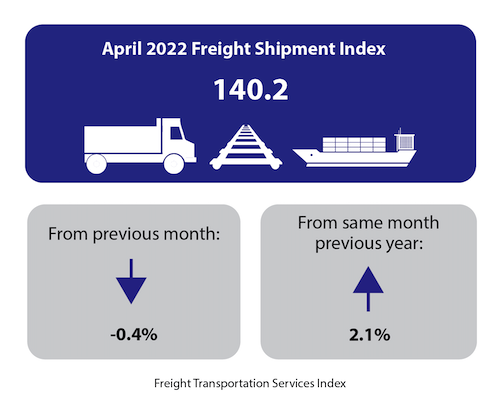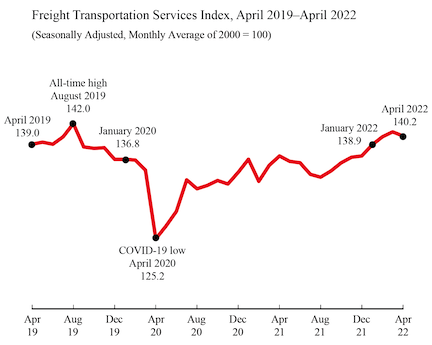
The Freight Transportation Services Index (TSI), which is based on the amount of freight carried by the for-hire transportation industry, fell 0.4% in April from March, falling for the first month after seven months of consecutive growth, according to the U.S. Department of Transportation’s Bureau of Transportation Statistics’ (BTS). From April 2021 to April 2022 the index rose 2.1 percent compared to a rise of 9.7 percent from the COVID low month of April 2020 to April 2021 and a decline of 9.9 percent from pre-COVID April 2019 to April 2020 (Tables 1, 2, and 2A).

The level of for-hire freight shipments in April measured by the Freight TSI (140.2) was 1.3% below the all-time high level of 142.0 in August 2019 (Table 2A). BTS’ TSI records begin in 2000.
BTS is withholding the scheduled release of the passenger and combined indexes for April. The passenger index for April is a statistical estimate of airline passenger travel and other components based on historical trends up to March 2022. The statistical estimate does not fully account for the rapidly changing impacts of the coronavirus on the historical trend. Air freight for April is also a statistical estimate. Since air freight makes up a smaller part of the freight index, the freight TSI is being released as scheduled with the air freight estimate included.
The Freight TSI measures the month-to-month changes in for-hire freight shipments by mode of transportation in tons and ton-miles, which are combined into one index. The index measures the output of the for-hire freight transportation industry and consists of data from for-hire trucking, rail, inland waterways, pipelines and air freight. The TSI is seasonally-adjusted to remove regular seasonal movement, which enables month-to-month comparisons.
Analysis: The Freight TSI decreased 0.4% in April from March due to seasonally adjusted decreases in trucking and rail carloads, while rail intermodal, air freight, water and pipeline grew.
The April decrease came in the context of mixed results for several other indicators. The Federal Reserve Board Industrial Production (IP) Index grew by 1.1% in April, reflecting increases of 0.8% in manufacturing, 2.4% in utilities, and 1.6% in mining. Housing starts were down 0.2%, and personal income increased by 0.4%.
The Institute for Supply Management Manufacturing (ISM) index was down 1.7 points to 55.4, indicating slowing growth in manufacturing.
Although the April Passenger TSI is being withheld because of the previously cited difficulty of estimating airline passenger travel and other components, the March index is now being released. The index increased 0.9% from February to March following an increase of 9.7% in February. Seasonally adjusted air passenger grew, while transit and rail passenger travel declined.
The Passenger TSI has now exceeded its level in March 2020 —the first month of the pandemic— for ten months in a row but remains below its pre-pandemic level (February 2020) for the 25th consecutive month.
Trend: The April freight index decrease was the first month-over-month decrease following seventh months of growth, for a total increase of 4.5% since August 2021. The April Freight TSI is 12.0% above the pandemic low in April 2020; it has increased in 16 of the 24 months since that low. The index is 1.3% below its record level of 142.0 set in August 2019 and has increased in 17 of the 32 months since that peak. It is at its second highest point since that record level.
Index highs and lows: For-hire freight shipments in April 2022 (140.2) were 47.6% higher than the low in April 2009 during the recession (95.0). The April 2022 level was 1.3% below the historic peak reached in August 2019 (142.0) (Table 1A).
Year to date: For-hire freight shipments measured by the index were up 2.1% in April compared to the end of 2021 (Table 3).
Long-term trend: For-hire freight shipments are up 11.7% in the five years from April 2017 and are up 25.1% in the 10 years from April 2012 (Table 5).
Same month of previous year: April 2022 for-hire freight shipments were up 2.1% from April 2021 (Tables 4, 5).
The TSI has three seasonally-adjusted indexes that measure changes from the monthly average of the base year of 2000. The three indexes are freight shipments, passenger travel and a combined measure that merges the freight and passenger indexes.
Revisions: Monthly data has changed from previous releases due to the use of concurrent seasonal analysis, which results in seasonal analysis factors changing as each month’s data are added.
BTS research has shown a clear relationship between economic cycles and the Freight and Passenger Transportation Services Indexes.
Table 1: Freight Transportation Services Index since October 2021
Percent Change from Previous Month
(Seasonally-Adjusted, Monthly Average of 2000 = 100)
SOURCE: Bureau of Transportation Statistics. See Transportation Services Index for documentation, data and other background information.
|
Freight | |
Index |
Percent change | |
October |
136.3 |
0.9 |
November |
137.1 |
0.6 |
December |
137.3 |
0.1 |
January |
138.9 |
1.2 |
February |
140.1 |
0.9 |
March |
140.8 |
0.5 |
April |
140.2 |
-0.4 |
NOTE: Percent changes based on numbers prior to rounding.
Table 1A: Annual High and Low Points in Freight Transportation Services Index, 2009-2022
SOURCE: Bureau of Transportation Statistics. See Transportation Services Index for documentation, data and other background information.
Year |
Month of peak |
Value at peak |
Month of low |
Value at low |
2009 |
December |
101.8 |
April |
95.0 |
2018 |
November |
139.7 |
January |
131.7 |
2019 |
August |
142.0 |
December |
136.8 |
2020 |
January |
136.8 |
April |
125.2 |
2021 |
April |
137.3 |
February |
133.6 |
2022 (thru April) |
March |
140.8 |
January |
138.9 |
Table 2: Freight Transportation Services Index Monthly Changes, 2019-2022
Percent change from previous month
SOURCE: Bureau of Transportation Statistics. See Transportation Services Index for documentation, data and other background information.
|
2019 |
2020 |
2021 |
2022 |
Percent change |
Percent change |
Percent change |
Percent change | |
January |
0.9 |
0.0 |
1.4 |
1.2 |
February |
-0.6 |
-0.1 |
-2.3 |
0.9 |
March |
0.1 |
-1.1 |
1.7 |
0.5 |
April |
0.6 |
-7.4 |
1.0 |
-0.4 |
May |
0.2 |
1.5 |
-0.6 |
|
June |
-0.2 |
1.7 |
-0.1 |
|
July |
0.8 |
3.6 |
-1.2 |
|
August |
1.4 |
-1.0 |
-0.3 |
|
September |
-2.4 |
0.4 |
0.7 |
|
October |
-0.1 |
0.5 |
0.9 |
|
November |
0.1 |
-0.4 |
0.6 |
|
December |
-1.2 |
1.3 |
0.1 |
|
Table 2A: Freight Transportation Services Index by Month, 2019-2022
SOURCE: Bureau of Transportation Statistics. See Transportation Services Index for documentation, data and other background information.
|
2019 |
2020 |
2021 |
2022 |
January |
138.8 |
136.8 |
136.8 |
138.9 |
February |
138.0 |
136.7 |
133.6 |
140.1 |
March |
138.2 |
135.2 |
135.9 |
140.8 |
April |
139.0 |
125.2 |
137.3 |
140.2 |
May |
139.3 |
127.1 |
136.5 |
|
June |
139.0 |
129.2 |
136.3 |
|
July |
140.1 |
133.8 |
134.6 |
|
August |
142.0 |
132.5 |
134.2 |
|
September |
138.6 |
133.0 |
135.1 |
|
October |
138.4 |
133.7 |
136.3 |
|
November |
138.5 |
133.2 |
137.1 |
|
December |
136.8 |
134.9 |
137.3 |
|
Table 3: Freight Transportation Services Index Year-to-Date Change, 2013-2022
Percent change to April from December of the previous year
SOURCE: Bureau of Transportation Statistics. See Transportation Services Index for documentation, data and other background information.
Year |
Freight |
2013 |
2.4 |
2014 |
2.4 |
2015 |
-1.0 |
2016 |
2.1 |
2017 |
0.6 |
2018 |
1.3 |
2019 |
1.0 |
2020 |
-8.5 |
2021 |
1.8 |
2022 |
2.1 |
Table 4: Freight Transportation Services Index from Year-to-Year
Percent Change in the April Freight TSI
(Monthly average of 2000 = 100)
SOURCE: Bureau of Transportation Statistics. See Transportation Services Index for documentation, data and other background information.
|
April Freight TSI |
Percent change from same month previous year |
2013 |
115.0 |
2.6 |
2014 |
120.6 |
4.9 |
2015 |
122.0 |
1.2 |
2016 |
123.2 |
1.0 |
2017 |
125.5 |
1.9 |
2018 |
135.5 |
8.0 |
2019 |
139.0 |
2.6 |
2020 |
125.2 |
-9.9 |
2021 |
137.3 |
9.7 |
2022 |
140.2 |
2.1 |
NOTE: Percent changes based on numbers prior to rounding.
Table 5: Freight Transportation Services Index from Previous Years
Percent Change to 2022 (April to April)
SOURCE: Bureau of Transportation Statistics. See Transportation Services Index for documentation, data and other background information.
Since April . . . |
Duration in years |
Freight TSI percent change to April 2022 |
2021 |
1 |
2.1 |
2020 |
2 |
12.0 |
2019 |
3 |
0.9 |
2018 |
4 |
3.5 |
2017 |
5 |
11.7 |
2016 |
6 |
13.8 |
2015 |
7 |
14.9 |
2014 |
8 |
16.3 |
2013 |
9 |
21.9 |
2012 |
10 |
25.1 |
Brief Explanation of the TSI
The Transportation Services Index (TSI) is a measure of the month-to-month changes in the output of services provided by the for-hire transportation industries. The freight index measure changes in freight shipments while the passenger index measures changes in passenger travel.
The TSI tells us how the output of transportation services has increased or decreased from month to month. The index can be examined together with other economic indicators to produce a better understanding of the current and future course of the economy. The movement of the index over time can be compared with other economic measures to understand the relationship of changes in transportation output to changes in Gross Domestic Product (GDP).
The freight transportation index consists of:
For-hire trucking,
Railroad freight services (including rail based intermodal shipments such as containers on flat cars),
Inland waterways transportation,
Pipeline transportation (including principally petroleum and petroleum products and natural gas), and
Air freight.
The index does not include international or coastal waterborne movements, private trucking, courier services, or the US Postal Service.







